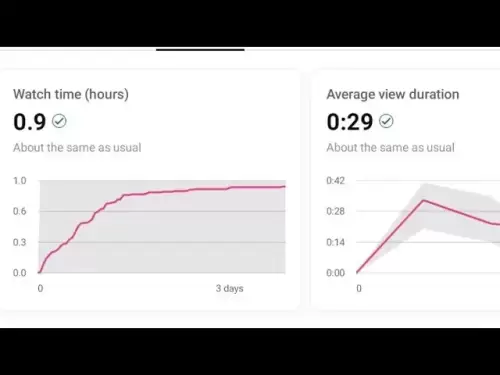-
 Bitcoin
Bitcoin $103,456.1111
0.49% -
 Ethereum
Ethereum $2,414.9631
0.02% -
 Tether USDt
Tether USDt $1.0006
0.05% -
 XRP
XRP $2.1083
0.24% -
 BNB
BNB $634.8760
-0.76% -
 Solana
Solana $139.8437
1.94% -
 USDC
USDC $0.9998
-0.01% -
 TRON
TRON $0.2737
0.97% -
 Dogecoin
Dogecoin $0.1602
0.20% -
 Cardano
Cardano $0.5737
1.08% -
 Hyperliquid
Hyperliquid $32.9779
-2.54% -
 Bitcoin Cash
Bitcoin Cash $474.8886
-1.80% -
 Sui
Sui $2.6272
-1.99% -
 Chainlink
Chainlink $12.4878
0.14% -
 UNUS SED LEO
UNUS SED LEO $8.9234
0.35% -
 Stellar
Stellar $0.2411
-0.18% -
 Avalanche
Avalanche $17.0274
-0.70% -
 Toncoin
Toncoin $2.8936
-1.11% -
 Shiba Inu
Shiba Inu $0.0...01112
-0.58% -
 Litecoin
Litecoin $82.6982
1.33% -
 Hedera
Hedera $0.1423
-0.05% -
 Monero
Monero $314.8455
3.26% -
 Ethena USDe
Ethena USDe $1.0006
0.01% -
 Polkadot
Polkadot $3.4043
1.14% -
 Dai
Dai $0.9999
0.01% -
 Bitget Token
Bitget Token $4.2848
-0.13% -
 Uniswap
Uniswap $6.8748
-5.45% -
 Pepe
Pepe $0.0...09661
0.52% -
 Pi
Pi $0.5359
1.19% -
 Aave
Aave $242.9168
-1.03%
The early warning accuracy of BTC's three crows in the top area
The bearish three crows pattern in BTC often signals a potential price reversal after an uptrend, especially when confirmed by indicators like RSI or MACD.
Jun 21, 2025 at 09:08 pm
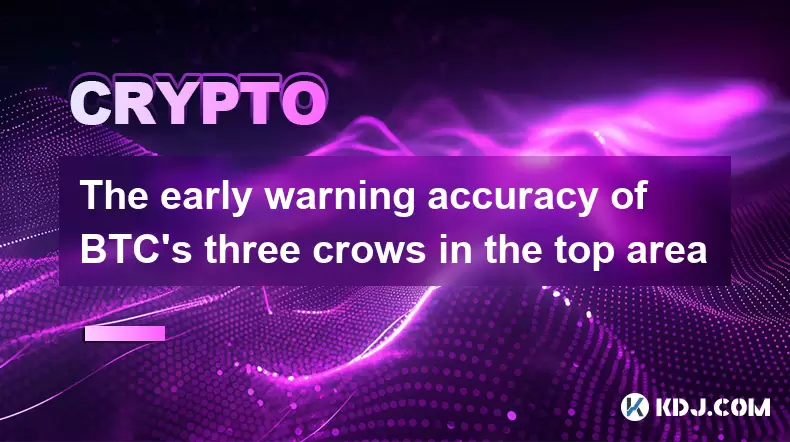
Understanding the Three Crows Pattern in BTC Trading
The three crows pattern is a well-known candlestick formation used by traders to predict potential reversals in price trends. In the context of Bitcoin (BTC), this pattern often appears at significant price peaks and can act as an early warning signal for traders anticipating a downward correction. The bearish three crows consist of three consecutive long red candles with short wicks, each closing lower than the previous one. When observed in the top area of BTC’s price chart, it may suggest that bullish momentum is fading and bears are gaining control.
Traders should be cautious when this pattern forms after a strong uptrend, especially if it coincides with overbought conditions on technical indicators like RSI or MACD.
Historical Accuracy of Three Crows in BTC Price Peaks
Analyzing historical data reveals that the three crows pattern has appeared multiple times near BTC's local or major tops, offering relatively accurate reversal signals. For instance, during the 2021 bull run, a textbook case of the bearish three crows formed just before BTC corrected from its all-time high around $64,000. Similarly, earlier patterns in 2019 and 2020 also preceded notable pullbacks.
- Each occurrence was followed by a minimum 10–15% correction within a week
- Volumes tended to increase significantly during the third crow candle
- RSI values dropped below 50 shortly after the pattern completed
These observations indicate that while not foolproof, the three crows have historically provided reliable early warnings for BTC tops.
How to Identify the Three Crows in BTC Charts
Correct identification of the three crows is crucial for effective trading decisions. Here's how you can spot this pattern on BTC charts:
- Look for three consecutive red candles following an uptrend
- Each candle should open within the range of the previous candle’s body
- Each candle should close progressively lower than the prior one
- Wicks should be small, indicating consistent selling pressure
Using platforms like TradingView or Binance’s native charting tools can help visualize these formations clearly. It's recommended to combine this pattern recognition with volume analysis and other technical indicators to confirm validity.
Combining Indicators for Enhanced Accuracy
To improve the reliability of the three crows as a top indicator for BTC, traders often combine it with complementary tools such as moving averages, RSI, and volume metrics. Here's how each element contributes:
- Moving Averages (e.g., 50 EMA): Confirm trend direction and possible crossover points
- Relative Strength Index (RSI): Look for overbought readings (>70) preceding the pattern
- Volume: Increasing volume during the formation enhances credibility
This multi-indicator approach helps filter out false signals and strengthens the probability of a genuine top forming.
Risk Management When Trading the Three Crows Signal
Even with a historically accurate pattern like the three crows, risk management remains essential. Traders must avoid entering trades solely based on candlestick patterns without proper stop-loss and position sizing strategies.
- Place stop-loss orders above the high of the first crow candle
- Use a risk-to-reward ratio of at least 1:2
- Consider partial profit-taking at key support levels
By adhering to disciplined risk practices, traders can protect capital while maximizing gains when the pattern accurately predicts a BTC top.
Frequently Asked Questions
Q: Can the three crows appear in intraday BTC charts?
Yes, the three crows can form on any time frame including 1-hour, 4-hour, and daily charts. However, the reliability increases on higher time frames like the daily chart due to reduced market noise.
Q: How does the three crows differ from the evening star pattern?
While both are bearish reversal patterns, the evening star includes a doji or spinning top between two candles, making it more complex. The three crows consist purely of three consecutive bearish candles without gaps or indecision candles.
Q: Should I always sell immediately upon seeing the three crows in BTC?
Not necessarily. Always verify with additional indicators like RSI divergence or volume spikes before making a trade decision. Some patterns may fail, especially in highly volatile crypto markets.
Q: Is there a bullish version of the three crows?
Yes, the bullish counterpart is known as the "three white soldiers." It appears at the bottom of downtrends and consists of three rising green candles, signaling a potential reversal upward.
Disclaimer:info@kdj.com
The information provided is not trading advice. kdj.com does not assume any responsibility for any investments made based on the information provided in this article. Cryptocurrencies are highly volatile and it is highly recommended that you invest with caution after thorough research!
If you believe that the content used on this website infringes your copyright, please contact us immediately (info@kdj.com) and we will delete it promptly.
- Is Ruvi AI the Next Binance Coin (BNB)? Audited Token Heats Up!
- 2025-06-22 02:25:12
- Altcoins to Watch: Kaanch Heats Up as Solana Cools Down
- 2025-06-22 02:45:11
- Shiba Inu's Market Woes: Crash Predictions and a New Meme Coin on the Rise
- 2025-06-22 02:25:12
- Sahara Token Rockets 40389% on Binance Listing Announcement: A New Era?
- 2025-06-22 02:45:11
- Crypto Coins 2025: BlockDAG Leading the Charge
- 2025-06-22 02:50:11
- Solana Price Check: Bearish Signals or Onchain Strength?
- 2025-06-22 02:55:12
Related knowledge
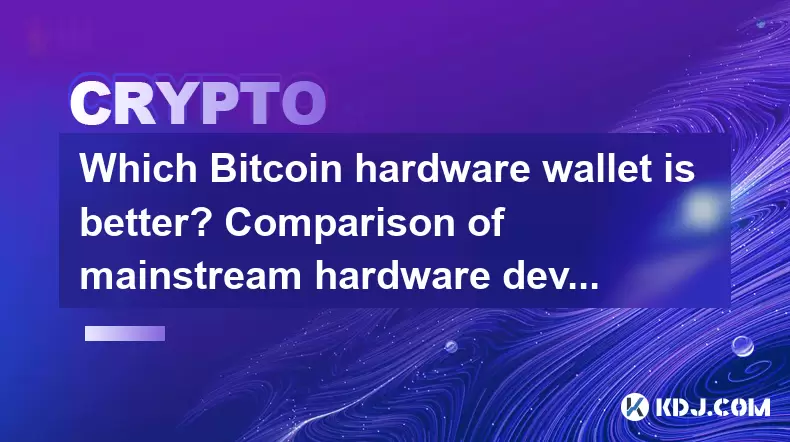
Which Bitcoin hardware wallet is better? Comparison of mainstream hardware devices
Jun 16,2025 at 02:08am
What Is a Bitcoin Hardware Wallet?A Bitcoin hardware wallet is a physical device designed to securely store the private keys associated with your cryptocurrency holdings. Unlike software wallets, which are more vulnerable to online threats, hardware wallets keep private keys offline, significantly reducing the risk of unauthorized access. These devices ...

What are Bitcoin non-custodial wallets? Self-controlled private key recommendation
Jun 16,2025 at 11:29pm
Understanding Bitcoin Non-Custodial WalletsA Bitcoin non-custodial wallet is a type of digital wallet where users retain full control over their private keys. Unlike custodial wallets, which are managed by third-party services such as exchanges, non-custodial wallets ensure that only the user can access and manage their funds. This means no intermediary...
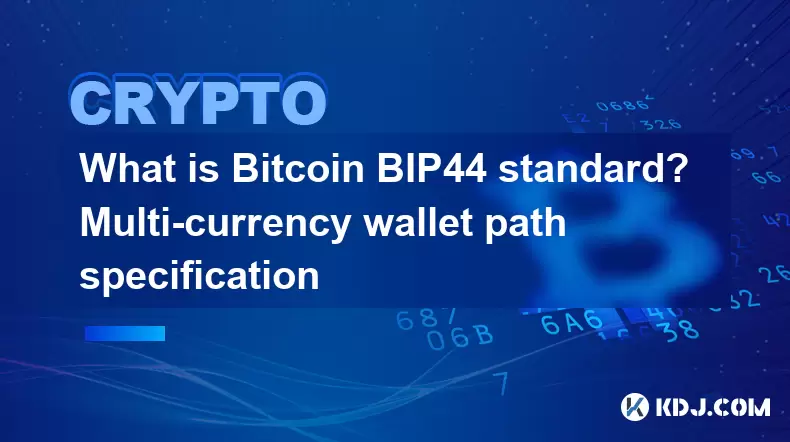
What is Bitcoin BIP44 standard? Multi-currency wallet path specification
Jun 15,2025 at 04:08pm
Understanding the BIP44 Standard in Bitcoin and CryptocurrencyThe BIP44 standard, which stands for Bitcoin Improvement Proposal 44, is a widely adopted hierarchical deterministic wallet structure used across various cryptocurrencies. It defines a structured path format that enables wallets to support multiple currencies while maintaining consistency and...

What is Bitcoin HD wallet? Advantages of layered deterministic wallets
Jun 16,2025 at 03:56pm
Understanding Bitcoin HD WalletsA Bitcoin HD wallet, or Hierarchical Deterministic wallet, is a type of cryptocurrency wallet that generates multiple keys and addresses from a single seed phrase. Unlike traditional wallets that create random private keys for each transaction, an HD wallet follows a structured hierarchy to derive keys in a deterministic ...

Is Bitcoin zero-confirmation transaction risky? Zero-confirmation usage scenarios
Jun 15,2025 at 03:57am
Understanding Zero-Confirmation Transactions in BitcoinBitcoin zero-confirmation transactions, often referred to as 'unconfirmed transactions,' are those that have been broadcast to the network but have not yet been included in a block. This means they have not received any confirmations from miners. While these transactions can be useful in certain con...
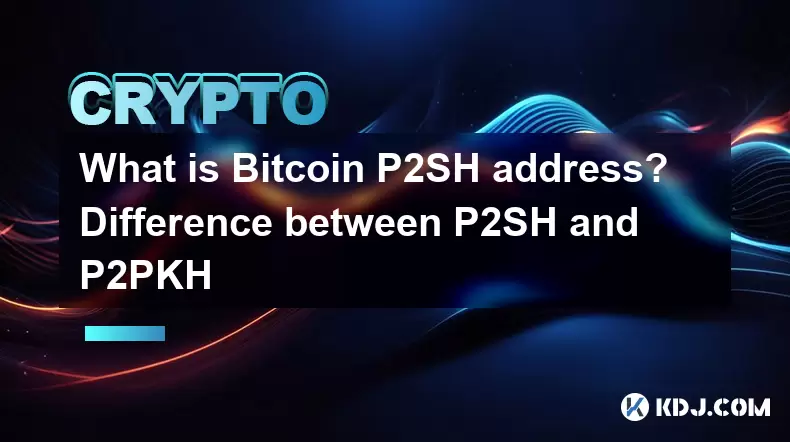
What is Bitcoin P2SH address? Difference between P2SH and P2PKH
Jun 16,2025 at 09:49pm
Understanding Bitcoin P2SH AddressesA Pay-to-Script-Hash (P2SH) address in the Bitcoin network is a type of address that allows users to send funds to a script hash rather than directly to a public key hash, as seen in earlier address formats. This innovation was introduced through BIP 16, enhancing flexibility and enabling more complex transaction type...

Which Bitcoin hardware wallet is better? Comparison of mainstream hardware devices
Jun 16,2025 at 02:08am
What Is a Bitcoin Hardware Wallet?A Bitcoin hardware wallet is a physical device designed to securely store the private keys associated with your cryptocurrency holdings. Unlike software wallets, which are more vulnerable to online threats, hardware wallets keep private keys offline, significantly reducing the risk of unauthorized access. These devices ...

What are Bitcoin non-custodial wallets? Self-controlled private key recommendation
Jun 16,2025 at 11:29pm
Understanding Bitcoin Non-Custodial WalletsA Bitcoin non-custodial wallet is a type of digital wallet where users retain full control over their private keys. Unlike custodial wallets, which are managed by third-party services such as exchanges, non-custodial wallets ensure that only the user can access and manage their funds. This means no intermediary...

What is Bitcoin BIP44 standard? Multi-currency wallet path specification
Jun 15,2025 at 04:08pm
Understanding the BIP44 Standard in Bitcoin and CryptocurrencyThe BIP44 standard, which stands for Bitcoin Improvement Proposal 44, is a widely adopted hierarchical deterministic wallet structure used across various cryptocurrencies. It defines a structured path format that enables wallets to support multiple currencies while maintaining consistency and...

What is Bitcoin HD wallet? Advantages of layered deterministic wallets
Jun 16,2025 at 03:56pm
Understanding Bitcoin HD WalletsA Bitcoin HD wallet, or Hierarchical Deterministic wallet, is a type of cryptocurrency wallet that generates multiple keys and addresses from a single seed phrase. Unlike traditional wallets that create random private keys for each transaction, an HD wallet follows a structured hierarchy to derive keys in a deterministic ...

Is Bitcoin zero-confirmation transaction risky? Zero-confirmation usage scenarios
Jun 15,2025 at 03:57am
Understanding Zero-Confirmation Transactions in BitcoinBitcoin zero-confirmation transactions, often referred to as 'unconfirmed transactions,' are those that have been broadcast to the network but have not yet been included in a block. This means they have not received any confirmations from miners. While these transactions can be useful in certain con...

What is Bitcoin P2SH address? Difference between P2SH and P2PKH
Jun 16,2025 at 09:49pm
Understanding Bitcoin P2SH AddressesA Pay-to-Script-Hash (P2SH) address in the Bitcoin network is a type of address that allows users to send funds to a script hash rather than directly to a public key hash, as seen in earlier address formats. This innovation was introduced through BIP 16, enhancing flexibility and enabling more complex transaction type...
See all articles
























